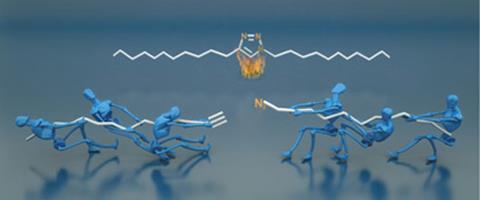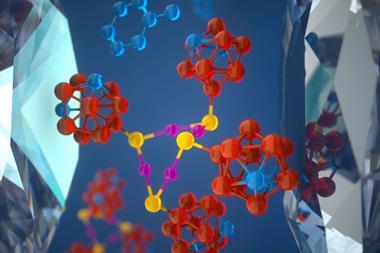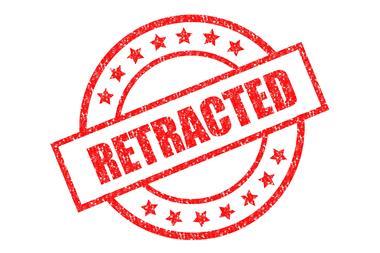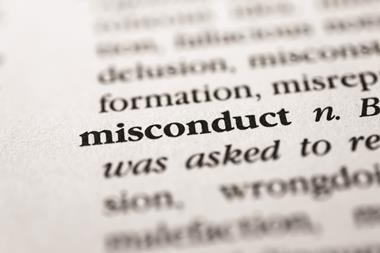Misconduct by member of Christopher Bielawski’s group has led to several retractions

High profile journals are retracting papers by Christopher Bielawski’s University of Texas, Austin, team amid an investigation into scientific misconduct. The moves follow Angewandte Chemie’s retraction of a 2012 paper from Bielawski’s team in January 2015.1 ‘A former research group member admitted to falsifying and/or fabricating data affecting this article,’ the Angewandte Chemie notice states.
Notices of concern regarding papers in Science2, Journal of the American Chemical Society (JACS)3,4,5,Journal of MaterialsChemistry6,7, Polymer Chemistry8 and Chemical Science9 have been published in the past few months and now the first retractions of these papers has been coming into effect – one paper in Science2 and three in JACS.3,4,5
While many authors contributed to these papers, just two are common to them all: Bielawski and his former PhD student Kelly Wiggins. Bielawski is now at the Ulsan National Institute of Science and Technology in Korea, a move he tells Chemistry World had been ‘in the works for several years’. For all other questions, he said he’d been asked to direct enquiries to the University of Texas. Chemistry World was unable to reach Wiggins for comment.
UT Austin says the US Family Educational Rights and Privacy Act limits what it can say about its investigation’s outcome. A spokesperson indicates that there was no common type of data falsified or fabricated between the different publications. They also confirm that one author told officials that they had ‘falsified and otherwise misrepresented data or figures in the papers’, acting alone.
Reader tip-off
Concerns first arose over the Science paper, in which Bielawski’s team sought to manipulate a polymer to mechanically pull apart a 1,2,3-triazole within its structure, formed by click chemistry. Acting on an email sent to Science by a reader, Bielawski ‘supervised a comprehensive evaluation’ according to the journal, ‘tracing all figures back to their raw data files’. ‘In over 50% of the figure parts, the authors deemed the data unreliable due to uncertainty regarding the origin of data or the manner in which the data were processed’, said a statement in Science in July 2014.

This spurred UT Austin to conduct a confidential investigation, which concluded in December 2014. The university went on to contact a swathe of journals where Bielawski and Wiggins had published studies about the outcome. The majority of these also exploited ‘polymer mechanochemistry’, where ultrasound’s effect on a polymer creates force that can drive specific reactions. For example, the Angewandte Chemie paper reported using the approach to prepare the chiral ligand (S)-binol in high yield and enantiopurity from a racemic precursor in a single step.
One of the JACS papers reported growing a polymer from a [4 + 2] cycloaddition adduct using an initiator originating from David Haddleton’s University of Warwick team. Polymerisation followed by ultrasound treatment carried out at UT Austin then reportedly reversed the cycloaddition, with the polymer mechanically pulling the ring apart. UT Austin also wrote to Haddleton, who was listed as an author on the paper, to notify him that it was in discussions with the publisher of JACS, the American Chemical Society.
‘The initiator was well-characterised, we have no concern at all about the work carried out at Warwick and were disappointed in how our material was used,’ Haddleton stresses. He adds that the retraction for this paper was submitted to JACS on the grounds of concerns about the work done at UT Austin. Haddleton is also editor-in-chief of Polymer Chemistry, where another affected paper was published, and voluntarily stepped aside from any involvement in the journal’s response to the situation.
‘Serious concern’
Rint Sijbesma from the Eindhoven University of Technology in the Netherlands has cited Bielawski’s polymer mechanochemistry work, though they’ve never collaborated directly. ‘It’s bad for science if people can’t rely on the literature,’ Sijbesma tells Chemistry World, noting that the effort required makes it particularly difficult to even try replicating the affected studies. However, Sijbesma’s team has successfully used the force polymer mechanochemistry creates to activate catalysts, and he says ‘it would be a pity’ if the field becomes tainted by association.
‘Some of the best scientists in the area of polymer chemistry are doing beautiful work that’s absolutely beyond reproach,’ Sijbesma says. ‘I think it’s already bad enough that it harms Chris Bielawkski’s reputation.’ He notes that while a principal investigator has the responsibility to make sure problems like this don’t arise, the primary blame ‘is with the researcher who fabricated the results’. ‘In this case it would have been very difficult to detect. I know the [Science] paper quite well and it all looks very sound and thorough.’
Iain Coldham, an organic chemist at the University of Sheffield, takes a firmer position. ‘The corresponding author is responsible for ensuring that an accurate account is presented and should be making every effort to verify that all the data are reliable and correct in the manuscript,’ he says. Coldham has previously stressed that chemistry papers have reproducibility problems, and says this case illustrates that the issues arise even in well-respected journals. ‘Such ethical violations in chemistry are likely to be few in number but nonetheless represent a serious concern. [The retractions] show the benefit of post-publication peer review.’
References
1 K M Wiggins and C W Bielawski, Angew. Chem., Int. Ed., 2012, 51, 1640 (DOI:10.1002/anie.201107937)
2 J N Brantley et al, Science, 2011, 333, 1606 (DOI:10.1126/science.1207934)
3 A G Tennyson et al, J. Am. Chem. Soc., 2010, 132, 16631(DOI:10.1021/ja107620y)
4 K M Wiggins et al, J. Am. Chem. Soc., 2010, 132, 3256 (DOI:10.1021/ja910716s)
5 K M Wiggins et al, J. Am. Chem. Soc., 2011, 133, 7180 (DOI:10.1021/ja201135y)
6 K M Wiggins et al, J. Mater. Chem., 2010, 20, 5709 (DOI:10.1039/C0JM00417K)
7 K M Wiggins et al,J. Mater. Chem., 2011, 21, 8355 (DOI:10.1039/C0JM03619F)
8 K M Wiggins and C W Bielawski, Polym. Chem., 2013, 4, 2239 (DOI:10.1039/C2PY20855E)
9 K M Wiggins et al, Chem. Sci., 2012, 3, 2986 (DOI:10.1039/C2SC20639K)












No comments yet